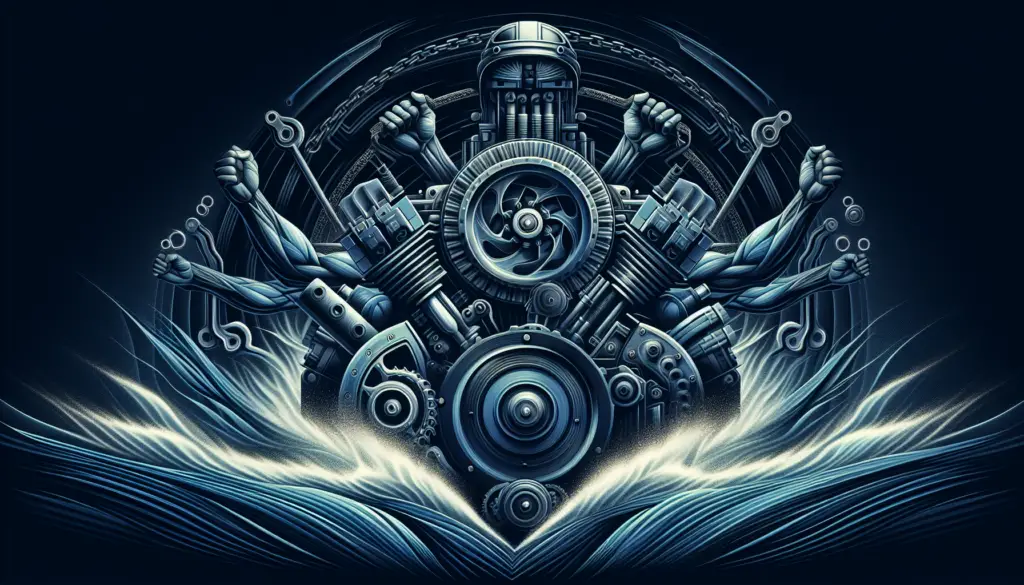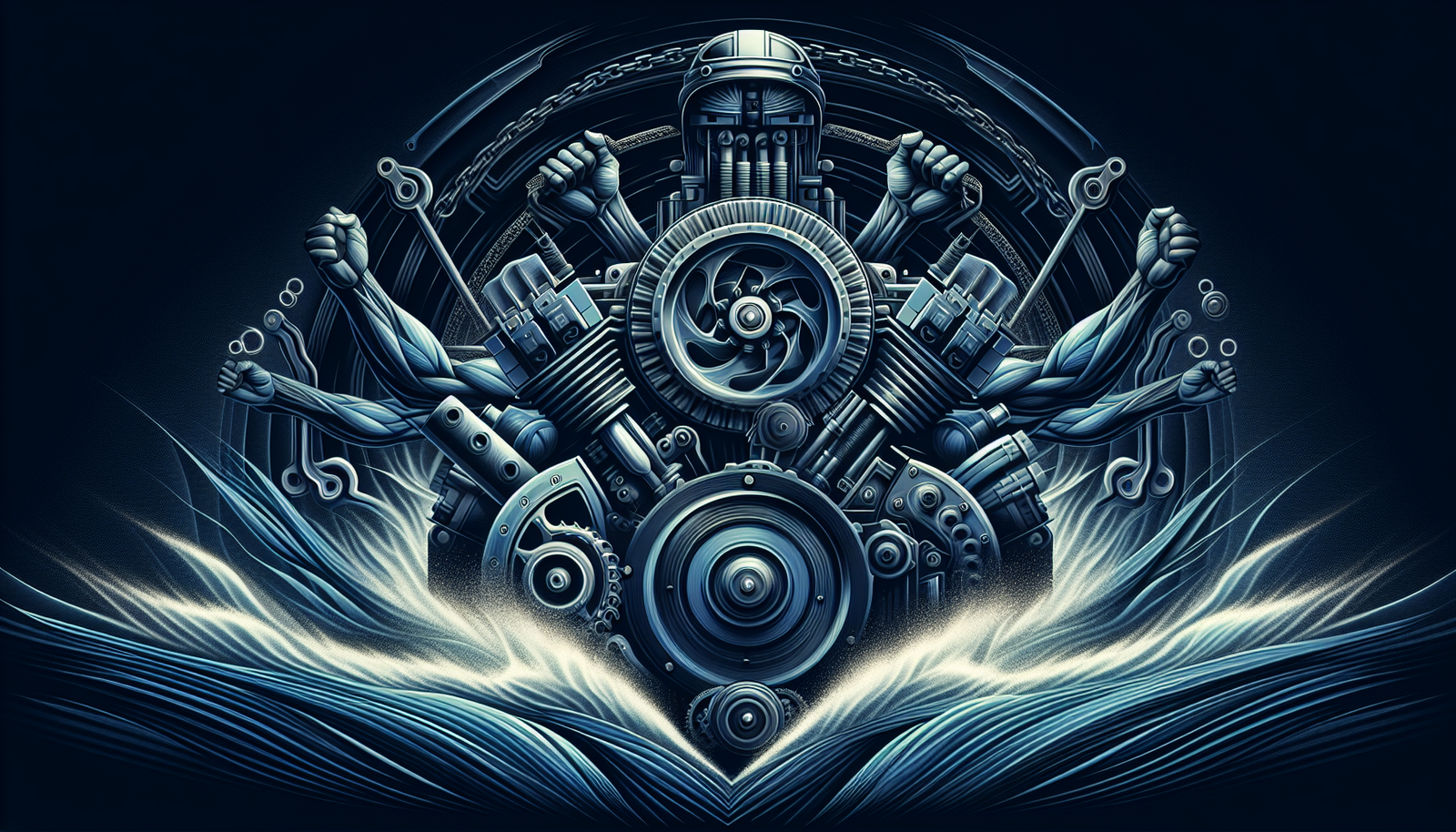Are you looking to maximize the power and performance of your boat engine? If so, we’ve got you covered. In this article, we’ll explore the best ways to increase torque in your boat engine, allowing you to smoothly glide through the water with ease. With these simple yet effective tips, you’ll be able to enhance the overall efficiency and capability of your boat, ensuring a more enjoyable and thrilling experience on the open water. So, buckle up and get ready to unleash the true potential of your boat engine!

1. Choosing the Right Propeller
Pitch
When it comes to choosing the right propeller for your boat engine, one important factor to consider is pitch. The pitch refers to the distance that a propeller would move forward in one complete revolution. A propeller with a higher pitch will provide more speed, while a lower pitch propeller will offer better acceleration and pulling power. To increase torque in your boat engine, it is recommended to choose a propeller with a lower pitch.
Diameter
Another crucial aspect to consider is the diameter of the propeller. The diameter refers to the distance across the propeller hub. A larger diameter propeller will generate more power and torque, making it ideal for boats that require higher pulling power or are used for towing purposes. On the other hand, a smaller diameter propeller would be more suitable for boats that prioritize speed over torque. When aiming to increase torque, opt for a propeller with a larger diameter.
Cupping
Cupping refers to the curvature or cup shape present at the trailing edge of the propeller blades. A propeller with more cupping will provide better grip on the water, resulting in increased torque and thrust. This can be particularly beneficial when trying to achieve a quick acceleration or when carrying a heavy load. Therefore, consider selecting a propeller with increased cupping to enhance the torque output of your boat engine.
Blade Count
The number of blades on a propeller also influences the torque output of your boat engine. Generally, propellers with more blades will produce greater torque and pulling power, while propellers with fewer blades will focus on speed and efficiency. When aiming to increase torque, selecting a propeller with a higher blade count is recommended. However, keep in mind that increasing the number of blades may decrease the overall speed of your boat.
2. Upgrading the Exhaust System
Replacing the Mufflers
One effective way to increase torque in your boat engine is to upgrade the exhaust system by replacing the mufflers. Stock mufflers are often restrictive, limiting the flow of exhaust gases and inhibiting the engine’s ability to produce torque. By installing high-performance mufflers, you can decrease the back pressure and optimize the exhaust flow, resulting in improved torque output.
Installing Performance Headers
Performance headers are another component that can greatly enhance the torque capabilities of your boat engine. These headers provide smoother and more efficient exhaust gas flow by replacing the stock exhaust manifold. Performance headers are specifically designed to reduce back pressure and increase the scavenging effect, resulting in improved torque and power.
Using High-Flow Catalytic Converters
Upgrading to high-flow catalytic converters can further enhance the torque output of your boat engine. Catalytic converters are designed to reduce emissions, but they can also restrict the flow of exhaust gases. By switching to high-flow catalytic converters, you can significantly reduce the back pressure and allow for a smoother exhaust flow, thereby increasing torque and overall engine performance.
Adding a Performance Exhaust System
Investing in a complete performance exhaust system can provide the ultimate boost in torque for your boat engine. Performance exhaust systems include high-performance mufflers, performance headers, and occasionally high-flow catalytic converters. By replacing the entire stock exhaust system with a performance-oriented one, you can maximize exhaust flow, minimize back pressure, and optimize torque production.

3. Optimize the Fuel System
Upgrading the Fuel Injectors
To increase torque in your boat engine, upgrading the fuel injectors is a worthwhile consideration. Upgraded fuel injectors provide a higher flow rate, allowing for a greater volume of fuel to be delivered to the engine. This increased fuel supply ensures better combustion, resulting in improved torque and power. It is essential to choose fuel injectors specifically designed for your boat engine to ensure compatibility and optimal performance.
Installing a Fuel Pressure Regulator
Installing a fuel pressure regulator can also optimize your boat engine’s fuel system and improve torque output. A fuel pressure regulator ensures that the fuel being delivered to the engine remains at a consistent and optimal pressure level. This consistent fuel pressure promotes better combustion and more efficient power delivery, resulting in increased torque and overall performance.
Using a Performance Fuel Pump
Upgrading to a performance fuel pump is another effective way to optimize your boat engine’s fuel system. Performance fuel pumps deliver a higher flow rate of fuel, ensuring a reliable and consistent supply to the engine. This increased fuel flow enables better combustion and enhanced torque production. When selecting a performance fuel pump, consider the specific fuel requirements of your boat engine to ensure compatibility and optimal performance.
Tuning the Fuel Mixture
Adjusting the fuel mixture can significantly impact torque output in your boat engine. A lean fuel mixture, characterized by a higher ratio of air to fuel, can improve fuel efficiency but may reduce torque. On the other hand, a rich fuel mixture, with a higher ratio of fuel to air, can increase torque at the cost of fuel economy. By fine-tuning the fuel mixture, you can optimize torque output based on your specific boating needs and preferences.
4. Enhancing the Ignition System
Upgrading to High-Performance Spark Plugs
One of the easiest and most effective ways to improve torque in your boat engine is by upgrading to high-performance spark plugs. High-performance spark plugs offer better ignition efficiency, ensuring a more complete and efficient combustion process. This enhanced combustion results in increased torque and improved engine performance. When selecting spark plugs, consider the heat range and design that best suits your specific boat engine.
Installing an Electronic Ignition System
Upgrading to an electronic ignition system can further enhance the torque capabilities of your boat engine. Electronic ignition systems offer better timing control and higher voltage spark delivery compared to traditional distributor-based systems. These advanced systems ensure optimal ignition timing, resulting in improved torque, power, and overall engine performance.
Adding a Performance Ignition Coil
Another component that can significantly improve torque output is a performance ignition coil. Performance ignition coils provide a stronger and more consistent spark, ensuring better ignition and combustion. The improved spark strength and duration contribute to increased torque and better overall engine performance. When selecting a performance ignition coil, choose one that is compatible with your boat engine’s ignition system and voltage requirements.
Using a Performance Ignition Module
Installing a performance ignition module can also boost torque in your boat engine. Performance ignition modules offer advanced timing control and often have additional features such as rev limiters and adjustable advance curves. These modules optimize ignition timing based on engine speed and load, resulting in improved torque output and overall engine efficiency.

5. Upgrading the Intake System
Installing a Cold Air Intake
Upgrading the intake system of your boat engine can significantly increase torque. One popular modification is installing a cold air intake. A cold air intake system allows cooler and denser air to enter the engine, improving combustion efficiency and increasing torque. By replacing the stock air intake system with a cold air intake, you can optimize airflow and enhance torque production.
Using a Performance Throttle Body
Another component of the intake system that can be upgraded is the throttle body. The throttle body controls the amount of air that enters the engine. By replacing the stock throttle body with a larger performance throttle body, you can allow for increased airflow, resulting in improved torque and power. However, it is important to ensure that the performance throttle body is compatible with your boat engine’s specifications.
Adding a High-Flow Air Filter
Upgrading to a high-flow air filter can further optimize the intake system and increase torque in your boat engine. High-flow air filters allow for a greater volume of air to enter the engine, providing better combustion and improved torque output. By replacing the stock air filter with a high-flow air filter, you can enhance the overall performance of your boat engine.
Tuning the Intake Manifold
Tuning the intake manifold is another way to optimize the intake system and increase torque. The intake manifold determines how air is distributed to the engine’s cylinders. By modifying the intake manifold, you can improve airflow distribution and promote better cylinder filling, resulting in increased torque. Professional tuning or specialized intake manifold modifications can help achieve optimal results.
6. Boosting the Compression Ratio
Installing High-Compression Pistons
To boost torque in your boat engine, consider installing high-compression pistons. High-compression pistons increase the compression ratio within the engine’s cylinders, leading to better combustion and improved torque output. However, it is important to note that modifying the compression ratio can also impact engine reliability and may require additional modifications for optimal performance and reliability.
Using a Performance Cylinder Head
Upgrading to a performance cylinder head is another effective way to increase torque. Performance cylinder heads feature larger intake and exhaust ports, improved valve flow, and optimized combustion chamber design. These enhancements result in improved airflow and better combustion efficiency, leading to increased torque and overall engine performance. When selecting a performance cylinder head, consider compatibility with your boat engine and the specific performance goals you have in mind.
Adding a Thicker Head Gasket
Increasing the thickness of the head gasket can also assist in boosting the compression ratio of your boat engine. A thicker head gasket reduces the combustion chamber volume, effectively increasing the compression ratio. This increase in compression ratio can help improve torque output. However, it is crucial to ensure that the addition of a thicker head gasket is compatible with your boat engine and does not exceed the manufacturer’s recommended limits.
Optimizing Camshaft Timing
Another vital aspect to consider in boosting torque is optimizing camshaft timing. Camshaft timing dictates valve opening and closing events, affecting overall engine performance. Adjusting camshaft timing to favor low-end torque can significantly enhance torque output. Consult with a professional engine tuner or performance specialist to determine the camshaft timing that best suits your desired torque characteristics and boat engine specifications.

7. Adjusting the Timing and Ignition Advance
Checking and Adjusting the Timing
Ensuring accurate and optimal ignition timing is essential for maximizing torque in your boat engine. By checking and adjusting the timing, you can optimize the spark ignition sequence and improve torque output. Using timing lights and following the manufacturer’s specifications, you can adjust the ignition timing to achieve the desired torque characteristics and overall engine performance.
Modifying the Ignition Advance
Modifying the ignition advance is another effective method to adjust the timing and optimize torque output. By carefully adjusting the ignition advance curve, you can fine-tune the timing at different engine speeds and loads, maximizing torque and overall engine performance. Working with an experienced engine tuner or performance specialist is recommended to ensure precise adjustments and optimal results.
Using an Ignition Timing Controller
For more advanced timing adjustments, using an ignition timing controller can be beneficial. Ignition timing controllers allow for real-time adjustments of the ignition timing, providing greater control and flexibility. These controllers often offer features like programmable ignition curves and the ability to adjust timing based on specific parameters such as engine speed or load. With the ability to fine-tune ignition timing, you can optimize torque output and achieve superior engine performance.
Optimizing the Ignition Curve
Optimizing the ignition curve is another crucial step in adjusting the timing and advancing torque. The ignition curve refers to the timing of the spark throughout the engine’s RPM range. By fine-tuning the ignition curve, you can optimize timing to ensure maximum torque at different engine speeds. Advanced engine management systems or specialized ignition modules can provide the necessary control and flexibility to achieve an optimized ignition curve.
8. Decreasing Friction and Drag
Using Synthetic Engine Oil
Reducing internal friction is essential for maximizing torque in your boat engine. One effective way to achieve this is by using synthetic engine oil. Synthetic oils offer superior lubrication properties, reducing friction between moving parts and improving overall engine efficiency. By minimizing internal friction, you can optimize torque output and improve the longevity of your boat engine.
Installing Low-Friction Bearings
Upgrading to low-friction bearings is another method to decrease friction within your boat engine. Low-friction bearings, such as roller bearings or ceramic bearings, offer reduced friction and improved efficiency compared to conventional bearings. By replacing stock bearings with low-friction alternatives, you can decrease internal friction and enhance torque production.
Adding Engine Friction Reducers
Engine friction reducers or additives can also be used to decrease friction within your boat engine. These additives are specifically designed to reduce friction between moving parts, resulting in improved engine efficiency and increased torque output. When selecting engine friction reducers, ensure compatibility with your boat engine and follow the manufacturer’s instructions for proper usage.
Streamlining the Boat’s Body
Decreasing drag on your boat’s body can also contribute to increased torque. By streamlining the boat’s body, you can minimize resistance and allow for smoother movement through the water. This can be achieved by removing unnecessary accessories or equipment that create drag, ensuring a clean and aerodynamic boat shape. Streamlining the boat’s body can optimize torque output by reducing the resistance encountered when moving through the water.

9. Increasing Airflow and Cooling
Optimizing the Engine Cooling System
Optimizing the engine cooling system is essential for maintaining optimal operating temperatures and maximizing torque output. Ensure proper cooling system maintenance, including regular inspection and cleaning of cooling passages, checking coolant levels, and replacing worn-out components. A well-maintained cooling system ensures efficient heat dissipation, preventing overheating and potential power loss.
Installing a Performance Intercooler
If your boat engine is turbocharged or supercharged, installing a performance intercooler can significantly enhance torque output. Performance intercoolers cool the compressed air before it enters the engine, increasing its density and subsequently optimizing combustion. This results in improved torque production and overall engine performance. When selecting a performance intercooler, consider your boat engine’s specific requirements and compatibility.
Upgrading the Cooling Fan
Upgrading the cooling fan can also contribute to increased airflow and cooling efficiency. High-performance cooling fans provide improved airflow, ensuring better heat dissipation and overall engine cooling. By installing a high-performance cooling fan, you can enhance the cooling system’s effectiveness, resulting in improved torque and power delivery.
Adding Air Ducts or Scoops
Adding air ducts or scoops to your boat’s body can further increase airflow and cooling. These components channel outside air to critical engine components, promoting better cooling and preventing overheating. Improved airflow and cooling contribute to optimal torque production, ensuring consistent and reliable engine performance.
10. Tuning and Programming the Engine
Using an Engine Control Unit (ECU) Programmer
Using an engine control unit (ECU) programmer is an effective way to fine-tune your boat engine and maximize torque output. ECU programmers provide the ability to adjust various engine parameters, including fuel delivery, ignition timing, and throttle response. By customizing these parameters, you can optimize torque production based on your specific boating requirements and preferences.
Optimizing the Engine’s Parameters
When tuning your boat engine, it is essential to optimize various parameters such as air/fuel ratio, ignition timing, and idle speed. By carefully adjusting these parameters, you can fine-tune the engine’s performance to focus on torque output. Achieving the right balance and optimization of these parameters is crucial for maximizing torque and achieving optimal engine performance.
Customizing the Fuel and Ignition Maps
Customizing the fuel and ignition maps using specialized software or tuning tools can greatly enhance torque production. Fuel and ignition maps dictate the optimal fuel delivery and ignition timing at different engine operating conditions. By customizing these maps, you can fine-tune torque characteristics to match your specific boating needs. Professional engine tuners or performance specialists can provide the expertise needed for optimal customization.
Adjusting the Throttle Response
Throttle response plays a significant role in torque production. Adjusting the throttle response, particularly on electronic throttle control systems, can enhance torque output and overall engine performance. Customization of throttle response can be achieved through an engine control unit (ECU) programmer or performance tuning software. By adjusting the throttle response, you can optimize torque delivery and ensure a more responsive and powerful boat engine.
In conclusion, increasing torque in your boat engine involves a combination of upgrading various components and fine-tuning engine parameters. By choosing the right propeller, upgrading the exhaust system, optimizing the fuel system, enhancing the ignition system, upgrading the intake system, boosting the compression ratio, adjusting the timing and ignition advance, decreasing friction and drag, increasing airflow and cooling, and tuning and programming the engine, you can significantly enhance torque output and overall engine performance. Consider your specific boating needs and consult with professionals for optimal results.

